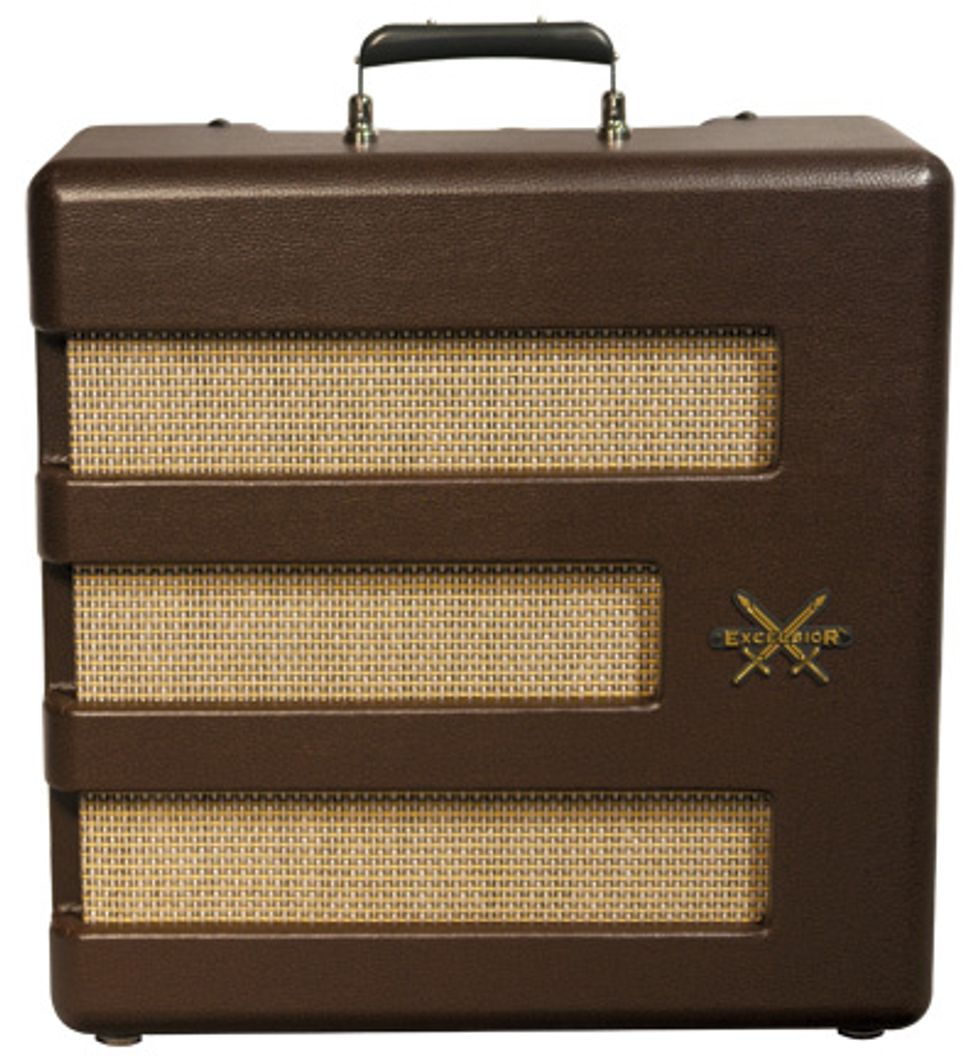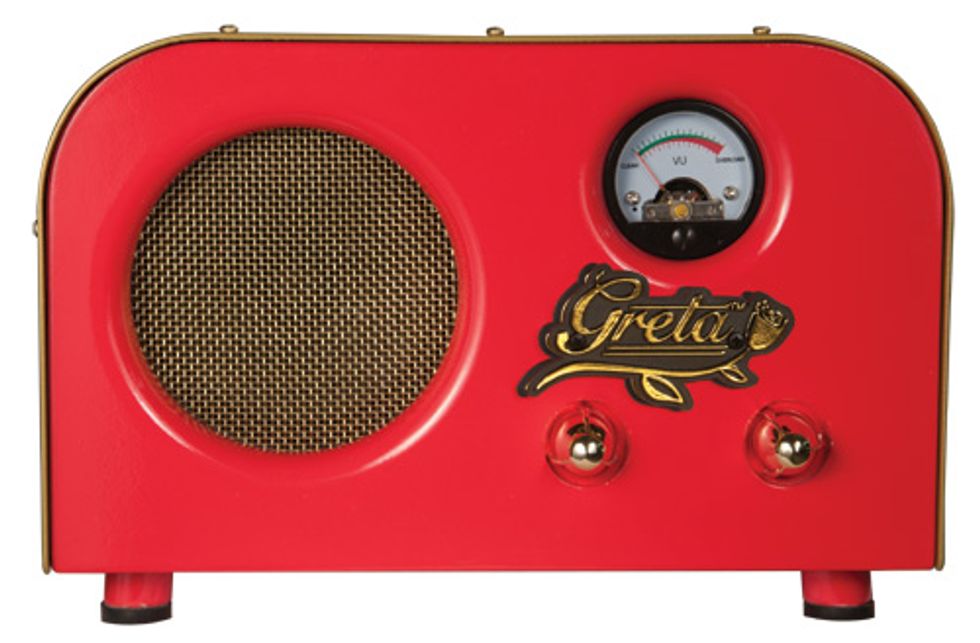And though the Excalibur and Greta differ significantly in terms of look and function, each is a ticket to funky realms that can prompt inspiration and fresh thinking about tone, recording, and performance possibilities.
The annals of rock guitar history are filled with tales of resourceful players getting killer sounds with crusty, busted, decrepit, funky off-brand equipment from the dustiest corners of the junk shop. Some such legends have become so, well, legendary, that these castoff gear artifacts have become Excaliburs and Holy Grails in their own right—and a cottage industry of electronic alchemists keen to capture the mojo of everything from Jimmy Page’s Supro Thunderbolt to Dan Auerbach’s Companion Fuzz has arisen in the wake of these tales.
Despite their status as an industry vanguard and giant, Fender has built their share of gear that fit this bill. And though their offerings have been, on the whole, a bit out of reach for truly destitute players for a while now, the company’s early overachievers—like the Champion series and White amplifiers—were among the first to rise from trash to treasure status. Fender’s new Pawn Shop series amplifiers, the Excelsior and Greta, are a nod to the style and sonic potential of those amplifiers and their contemporaries—many built by makers long since relegated to history’s dustbin. And though the Excelsior and Greta differ significantly in terms of look and function, each is a ticket to funky realms that can prompt inspiration and fresh thinking about tone, recording, and performance possibilities.

Excelsior
In not displaying the Fender name anywhere prominently, Fender has playfully created a cool brand that never was. Indeed, the 13-watt Excelsior looks and sounds like it could have been conceived as some electronics division of Montgomery Ward or a radio manufacturer with grand designs on diversification in the ’50s. To that end, the Excelsior gets a lot of the details from that period in amplifier amplification right.
The back of the amp is wide open, with the transformer and tube section of the chassis mounted on the bottom section of the amp, and the control section placed in an enclosed section at the top—a common approach to amp layout in the ’50s. The two 6V6 power tubes are enclosed in a metal cage that keeps them cool and out of harm’s way. You’ll also notice the considerable bulk of the 15" speaker, a nod to 15-equipped accordion amps from the Eisenhower era, given how many amps from the period had smaller 8" and 10" speakers—and one that pays big sonic dividends.
The control panel, which is part of the upper-chassis enclosure, is finished in the gray finish you see on old toolboxes, and the control set is refreshingly simple: a volume knob, a knob for the tremolo rate, and a slider for moving between dark and bright settings. To the right of the volume knob, there are three inputs—a standard guitar input, a mic input that has a pad for handling high-output instruments, and an accordion input that gives you a little low-end roll off and a little more presence in the highs and midrange.
In Excelsis Play-O
If you have experience with playing little Fenders, Silvertones, Gibsons, Magnatones, and other small amps from the period that inspired this amp, you’ll be struck by how well the Excelsior nails the compressed and explosive-to-mellow character of those amplifiers. With the single-coil output of a Danelectro 3021 reissue and a Stratocaster driving the Excelsior, I could run through a range of tones from sparkling to filthy, though the amp naturally gravitates toward dirty tones at any substantial volume.
Ratings
Pros:
’50s-cool looks. Well-built. Interesting range of tones. Great overdrive.
Cons:
Not much clean headroom.
Tones:
Ease of Use:
Build:
Value:
Street:
$299
Fender
fender.com
Clean tones really are only available in the lower third of the amp’s volume range, and they’re best accessed with the help of single-coils—or humbuckers whose volume controls are rolled back a touch. This limitation makes the Excelsior a tough proposition for players who need clean tones at performance levels, though it records beautifully at these settings. The 15" speaker lends a little extra low-end color and headroom that give the amp a unique clean voice, and that definitely complements the amp’s somewhat bright voicing.
With the volume up past a third of full, things get gritty fast. At around noon, tones from the bridge pickup take on a cool, Tweed Deluxe-like combination of compression and bite, though it lacks the balance and airiness of a Deluxe—or a Champ for that matter. What it does share with the Deluxe is a penchant for cool, honking midrange that rules for rhythm parts and slurry, percussive, Chuck Berry-/Keith Richards-style leads. When the Excelsior is wide open, it’s all attitude. It growls with an authority worthy of early James Gang or ZZ Top—especially with the bright switch on. A hanging, first-position A chord sustains as if it were coming from an amp twice its size—thanks, again, in no small part to the larger speaker—and leads are all fangs and beautiful high-mid wail. Throw a primitive fuzz, like a Tone Bender or a Fuzz Rite, in front of the cranked Excelsior, and you’ll be awash in glorious, fried, busted, and screaming lead tones that teeter between gloriously singing and chaotic.
The tremolo is a beautifully contoured pulse—neither too choppy nor too flat—that can move from a sexy, noir-ish rate to a fast, sci-fi-wave undulation. It works beautifully with the amp’s clean tones in particular, but it will stay defined through most of the amp’s volume range. It’s only when you really push overdriven chords through the slower reaches of the tremolo’s range that you start to significantly lose detail.
The Verdict
If you’re used to contemporary clean and/or high-gain flavors, the Excelsior will take some getting used to—or it might just prove entirely outside your vocabulary. But if you need an amp that can record with personality, from clean to filthy, or a little amp that can get bellicose enough to hang with a small, rockin’ combo without pedal assistance, the Exclesior has the goods to deliver.

Greta
Dressed up more like a mid-century Japanese radio than a guitar amplifier, the 2-watt Greta looks like it was designed to live in disguise. And indeed, the primary mission of Greta is to be the amplifier you can tuck away next to the reading lamp or on your work desk without offending the sensibilities of those who don’t see beauty in a tattered Champ quite like you do. Life as a double agent isn’t all that Greta does, however.
With a 12AT7 power tube and a 12AX7-driven preamp, Greta can be a little more responsive than your average desktop practice amp. And with line and speaker outputs, you can actually use it to drive an external cabinet or run it out to a larger amplifier. It also has a 1/8" auxiliary input for plugging in your mp3 player.
In many ways, Greta is a pretty cool piece of retro design and an imaginative way to package an unobtrusive practice amp. Its radio-like lines are attractive and will likely prompt a double take among those who aren’t in on the visual subterfuge. The coolest visual element is the backlit, test-instrument-like needle readout, which provides a visual indication of where you are in the clean-to-overdriven range of the amp. However, a few design touches may strike some as less than appealing, even given the pawnshop inspiration: The sum total of the garish, lipstick-red wooden front panel, the unsubstantial-feeling, gold-colored plastic knobs, and the stamped-plastic name badge is a look you might expect from a novelty item more than a pawnshop prize. That said, overall build quality is sturdy enough.
Ratings
Pros:
Imaginative package for a practice amp.
Cons:
Few useful tones for anyone but lo-fi junkies. Some low-quality materials. Expensive.
Tones:
Playability/Ease of Use:
Build:
Value:
Street:
$199
Fender
fender.com
Little Mr. Bojangles
Once you plug in, the Greta is most comfortable delivering clean, subdued tones that won’t wake the family or neighbors. And it’s in these lowest reaches of the amp’s volume range that you also hear the most tube character. Lowering the tone control also helps enormously on this front, and a Stratocaster or Telecaster at these levels will sound great and surprisingly rich for jangling arpeggios and Mark Knopfler- or Richard Thompson-style leads that benefit from middle or out-of-phase pickup positions and a roll off of the guitar’s tone. Set up this way, the Greta is perfect for recording demos or deliberately lo-fi applications.
Despite its tube circuit, the Greta runs up against its biggest shortcomings at more aggressive volume and tone settings. When pushed, the 4" speaker tends to break up in a manner that most players probably won’t find appealing, and it gets downright harsh with both volume and tone controls wide open and a bridge pickup selected. If you move to your neck pickup and roll back the tone, it’s possible to get some pretty cool Randy California-like, super-compressed and muffled lead tones that will actually record pretty well. However, chording at these settings tends to yield a less-than-pleasant sludge unless you’re working at very slow tempos with more open jazz voicings. The amp definitely sounds better through an external cabinet, and it will drive any 8-ohm cab—though the tones will still be of the very lo-fi variety.
The Verdict
Most players do not expect a practice amp to sound like a Princeton, but even with the lower expectations this product category instills, many players are likely to see Greta’s nearly $200 street price as rather steep. Like any practice amp, she does have tones that will reward adventurous players—especially in studio situations. But she also never quite realizes the potential implied by her tube circuitry. Which is a shame, because there are other small amps on the market that will do the job for significantly less cash—even if they’re a lot less fun to look at.

